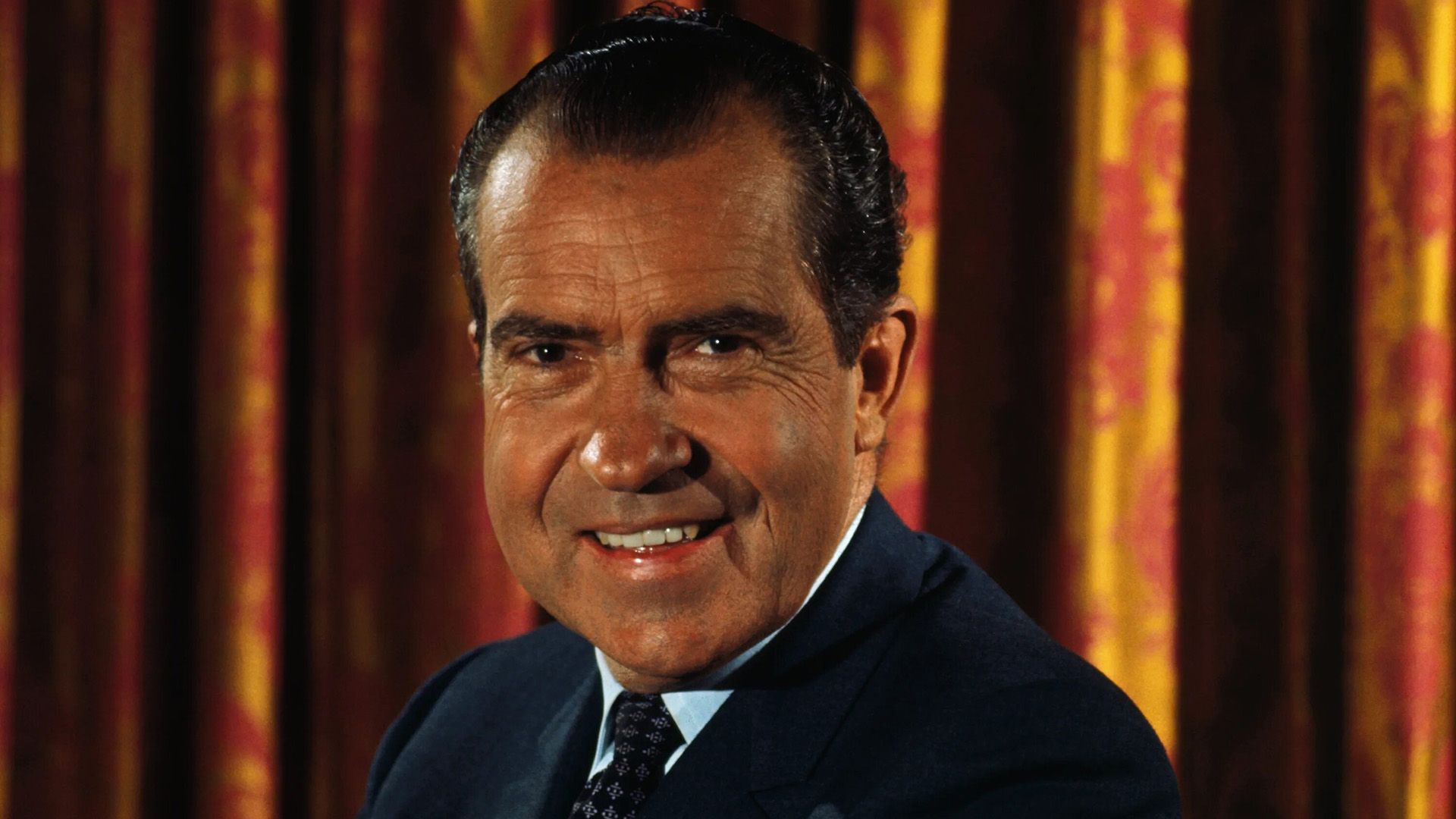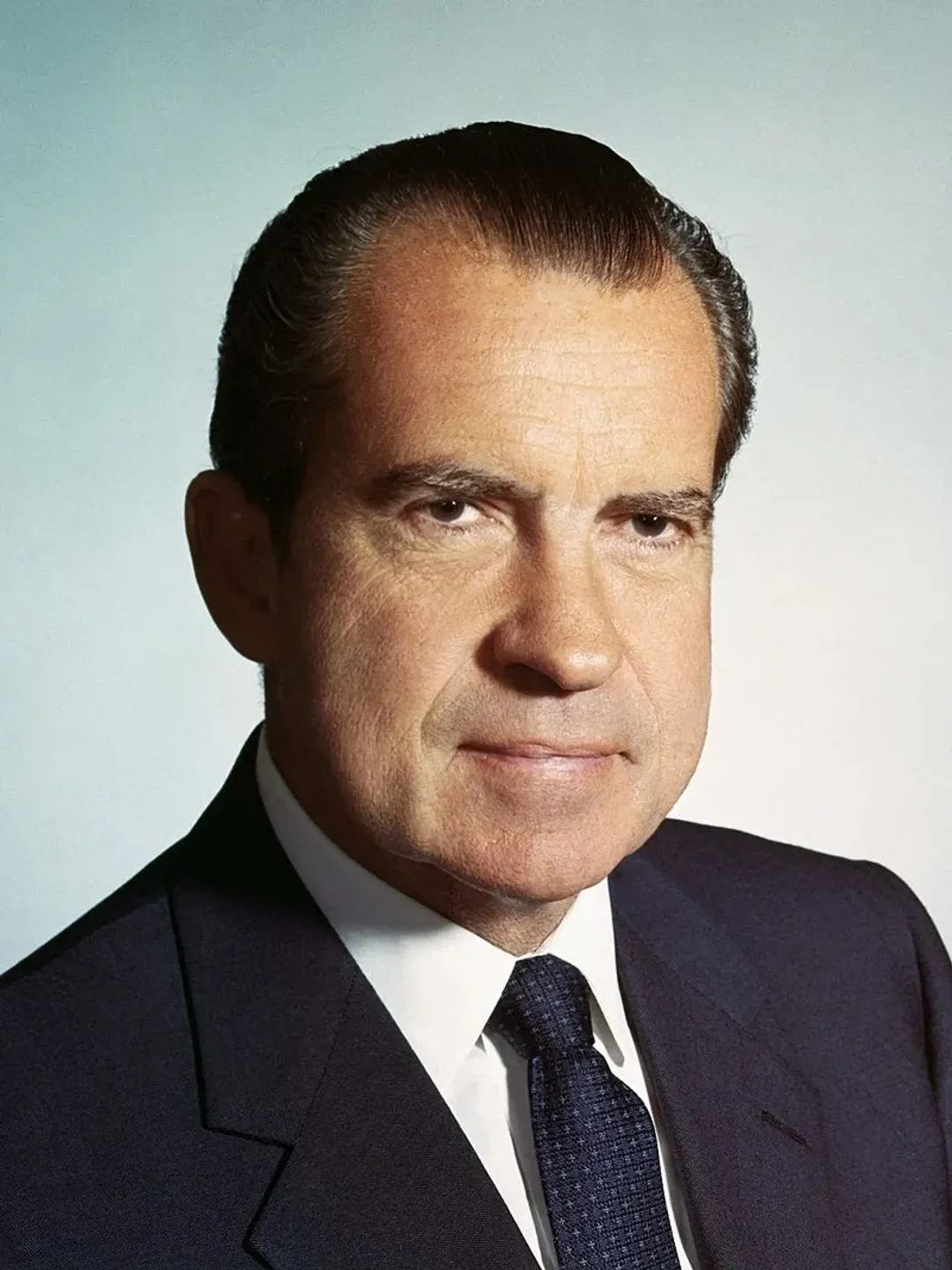Biography of Richard Nixon
Richard Nixon served as America's 37th President from 1969 to 1974, becoming the first commander-in-chief to resign from office amid the Watergate scandal. His presidency was defined by pulling American forces out of Vietnam, a withdrawal he personally orchestrated.
Childhood, Youth, Family
Richard Milhous Nixon was born in winter 1913 to Francis Nixon and Hannah Milhous Nixon in Yorba Linda, California. His Scottish father ran a grocery store while his mother managed the household and raised the children. They had five sons in total.Their father named each son after British kings, giving Richard's brothers equally regal names: Harold (died in 1933 at age 22), Donald, Arthur (died in 1925 at age 7), and Edward. The future president got his name from Richard the Lionheart.
Richard spent his early childhood on a lemon ranch. The children were raised strictly: his mother attended a Quaker community and, following their beliefs, soon introduced the entire family to them. Even as he grew older, Nixon couldn't drink alcohol, swear, or go to dances. Despite never learning to read music, he mastered several instruments: the clarinet, accordion, violin, and piano.
The family lived quite modestly. Richard started school in Whittier, where the Nixons moved in 1922. His father's fortunes turned around there—he opened both a grocery store and gas station. All the boys pitched in wherever needed—at home, the store, and the gas station.
Despite his family responsibilities, Richard excelled academically and entered a local college in 1930, even though Harvard had offered him a spot. But the family simply couldn't afford such an elite education.
After college, Nixon continued his education at the Durham Law School, established at Duke University. Richard secretly dreamed of becoming an FBI agent, but in 1937 he returned to California to work as an associate at the Wingert and Beale law firm.
A year later, he relocated to La Habra to start his own practice and eventually bought into the law firm. Nixon's legal background would later serve him well in politics, but after Pearl Harbor in early 1942, he voluntarily enlisted in the military and earned the rank of lieutenant in the U.S. Navy that same year. In 1946, he finished his service with the rank of lieutenant commander.
Political Career
Richard was 33 years old when he became a member of the U.S. House of Representatives from California. At that time, he had been discharged from the Navy as a lieutenant commander and had defeated Jerry Voorhis in the elections.He served two terms in the House of Representatives, serving on the House Un-American Activities Committee investigating communist infiltration. He played a key role in exposing Soviet spy Alger Hiss through testimony from Whittaker Chambers. According to Nixon himself, the investigation brought him national fame and was one of the key events in his political life.
In 1953, Nixon was elected Vice President in Dwight D. Eisenhower's administration and moved with his family to Washington. However, he nearly lost this position and could have destroyed his political career if not for his famous "Checkers speech."
In 1952, Senator Nixon was a candidate for Vice President. In September, the New York Post published an article about a group of businessmen who created a secret fund for Nixon amounting to $18,000. Democrats cried corruption, and the press ran with the scandal.
The situation was serious, and influential Republicans demanded Nixon be removed from the ticket. Even Eisenhower hesitated about whether to support his running mate. Nixon faced total ruin and made a desperate gamble: going directly to the American people on television. On September 23, 1952, he bought 30 minutes of airtime. It was a huge risk—live TV, no script, just Nixon and the camera.
Nixon began with a detailed account of his finances. He laid out every penny of his income and debts, right down to a loan from a furniture store. He explained that the fund was used exclusively for political expenses, not personal gain. But he saved his ace in the hole for the speech's finale.
Nixon shared that he received one special gift he intended to keep—a little black-and-white spaniel his daughters named Checkers:
This heartfelt, emotional moment completely flipped the script. Viewers didn't see a corrupt politician—they saw an ordinary guy, a loving father, and a dog owner. The speech was a huge success—Republican Party phone lines lit up with calls backing Nixon.It was a little cocker spaniel dog in a crate that he'd sent all the way from Texas. Black and white spotted. And our little girl—Tricia, the 6-year-old—named it Checkers. And you know, the kids, like all kids, love the dog and I just want to say this right now, that regardless of what they say about it, we're gonna keep it.
After the speech, Eisenhower kept Nixon on the ticket, and they won the election. The "Checkers speech" became a classic of political communication—the first instance of a politician using television to speak directly to the people in a critical moment.
Interestingly, many years later, already president, Nixon said he was embarrassed by the excessive sentimentality. But one thing's certain: that little dog mention saved his career and opened the door to the presidency. The phrase "Checkers speech" became proverbial. Incidentally, Checkers lived until 1964 and arguably became the most famous dog in American political history—at least until the Clinton White House pets came along.
In 1960, Richard Nixon was nominated by the Republican Party for the presidential election. He lost to John Kennedy, who then took the White House, by just 0.2 percent.
Two years later, Nixon attempted to become governor of California but failed. He then returned to practicing law and wrote a memoir about his political and government activities titled "Six Crises." Convinced his political career was finished, he moved to New York and opened a law firm. In 1964, Nixon worked on Barry Goldwater's presidential campaign (Goldwater lost decisively to Democrat Lyndon Johnson), and in 1968 he ran for president and defeated two contenders: Democrat Hubert Humphrey and George Wallace, who ran as an independent. Nixon captured 43.4% of the vote, while Humphrey took 42.7%.
Presidential Term
In November 1968, Richard Nixon became the President of the United States and focused on foreign policy while slashing domestic spending. He cut funding for poverty programs, agriculture, and social projects. Living standards dropped, sparking unrest, demonstrations, and protests that were brutally suppressed. Military spending dominated the budget, loan interest rates climbed, and the oil crisis hit.In foreign policy, the president aimed to ease international tensions. He directed National Security Advisor Henry Kissinger to pull out a significant number of U.S. troops from Vietnam while launching efforts to improve relations with China and the Soviet Union.
In 1972, Nixon entered the White House for a second term, crushing Democrat George McGovern, who took a firm anti-war stance. Nixon's first move in his second term was visiting China to meet with Mao Zedong, then traveling with his wife to the Soviet Union, where he was welcomed by Leonid Brezhnev. The result of the meeting was the signing of the SALT I treaty by the heads of state. The document aimed to limit the nuclear arsenals of the U.S. and the USSR.
Watergate Scandal
1974 spelled disaster for Nixon's political career. However, it all began in June 1972 when security at the Watergate complex in Washington caught five burglars at the Democratic Party headquarters. During the search, they found spying equipment and a large sum of money. It looked like a routine burglary, but two young Washington Post reporters, Bob Woodward and Carl Bernstein, started digging deeper.The journalists discovered that the burglars were connected to President Richard Nixon's re-election campaign. Despite the growing scandal, Nixon won the election decisively in November 1972—largely because his opponent, George McGovern, wasn't well-known to the public, and Nixon had painted him as a "crazy radical." At the time, many thought the break-in story would be forgotten.
But in early 1973, things got serious. Senate hearings began, and new details emerged. Turns out there was an entire system of political espionage against opponents running out of the White House, and the Watergate break-in was just the tip of the iceberg.
In the summer of 1973, a bombshell revelation occurred: Nixon had secretly recorded all conversations in his office. When Congress demanded the tapes, a battle for the recordings ensued. Nixon flat-out refused to hand them over, citing presidential privilege.
In October 1973, the "Saturday Night Massacre" happened—Nixon fired the special prosecutor investigating the case, which only deepened suspicions about his involvement in the scandal. Vice President Spiro Agnew resigned over corruption charges, and Gerald Ford replaced him.
In 1974, the Supreme Court ordered Nixon to turn over the tapes to investigators. When the tapes went public, they revealed that the president had discussed covering up evidence and paying bribes just a week after the break-in. This was the final straw.
In early August 1974, Republican leaders told Nixon his position was hopeless—impeachment was inevitable. On August 8, Richard Nixon announced his resignation in a televised address. The next day, he left the White House. Gerald Ford became the new president and soon pardoned Nixon. This marked the end of Richard Nixon's political career.
The Watergate scandal became a turning point in American history. It proved that even the president isn't above the law and spawned a culture of investigative journalism. Since then, any political scandal in the USA gets the suffix "gate," reminding us of those turbulent early '70s events.
Three years later, Nixon agreed to an interview with journalist David Frost—only because he desperately needed money. He never admitted guilt for many of the acts Frost grilled him about, but at the end of the interview, he said:
I made so many bad judgments. The worst ones: Mistakes of the heart rather than the head, as I pointed out. But let me say, the man in that top job has got to have a heart, but his head must always rule his heart.
Personal Life of Richard Nixon
At 25, Nixon was part of a local theater group when he met teacher Thelma Pat Ryan during auditions for the amateur production "The Dark Tower."The Irish beauty immediately caught the young lawyer's eye. He later admitted it was love at first sight—the moment he saw Pat, he told himself, "I'm going to marry this girl!" But Pat initially did not share his feelings. Nixon became more persistent than ever. He offered to drive Pat home after rehearsals and often chose the longest route just to spend more time together.
His courtship was unconventional for the era. Dick, as close friends called him, took Pat on dates in his beat-up car—they'd go grocery shopping and cook dinner together. He'd do anything for her—even pick her up before work to watch the sunrise at the beach.
Pat hesitated for a long time and even dated other men. But Richard's persistence and genuine devotion eventually won her over. On June 21, 1940, two years after their first meeting, they got married.
Their first daughter, Tricia, was born in 1946. Two years later came Julie (who would later marry David Eisenhower, grandson of the former president). Tricia married lawyer Edward Finch Cox, heir to a prominent New York judicial family.
The Nixon marriage proved remarkably solid, especially by Washington standards. Pat was Richard's main support through all his ups and downs. She stood by him during the famous "Checkers Speech" in 1952, when his political career hung in the balance. She supported him after his defeat in the California gubernatorial election in 1962. And, of course, she was there during the Watergate scandal and his subsequent resignation.
Nixon adored his wife and wasn't shy about public displays of affection—unusual for a politician of his generation. He wrote her poems and romantic letters, and even as president made time for romantic gestures. On their 30th anniversary, he secretly arranged to renew their vows at the White House.
Their love continued until Pat's death in 1993. In her final months battling lung cancer, Nixon remained by her bedside. After her death, he was inconsolable—he outlived her by just ten months.
Death and Memory of Richard Nixon
The thirty-seventh President of the United States died on April 22, 1994, from a stroke. Thousands came to pay their respects to the former president, whom many still respected and loved despite his controversial legacy. His fellow presidents, each having once occupied the Oval Office, also attended: Bill Clinton, Ronald Reagan, George H. W. Bush.Months after the funeral, director Oliver Stone created the political drama "Nixon," starring the incomparable Anthony Hopkins playing the main character. A decade later, Niels Mueller delivered the thriller "The Assassination of Richard Nixon," connecting the story to events that nearly brought down the presidency. Years later came a Nixon comedy starring Kevin Spacey, titled "Elvis & Nixon."
Interesting Facts
- In 1959, when Richard Nixon visited the USSR, he went to the cities of Sverdlovsk and Pervouralsk. During his journey, he made a stop in the small town of Degtyarsk. Soon after, a fascinating legend began circulating throughout the Soviet Union: Nixon's parents had allegedly visited the local copper mines back in 1925, bringing along young Richard, who reportedly enjoyed playing football with the local Soviet children. While this story never appeared in any American presidential biographies, Russian media and Yekaterinburg's official portal insist it's authentic, claiming Nixon's parents were employed by the British company Lena Goldfields.
- In 1973, during Leonid Brezhnev's visit to the USA, Nixon gave him a very warm welcome. Well aware of the Soviet leader's love for automobiles, Nixon presented him with a brand-new Lincoln Continental. The stunning dark blue vehicle, complete with black velour interior and a commemorative plaque on the dashboard, absolutely mesmerized Leonid Ilyich. Before Nixon knew it, Brezhnev had taken the wheel while the American president found himself relegated to the passenger seat. The security detail was completely beside themselves as the two world leaders took off and drove away at high speed. Nixon later loved recounting this ride.
- Richard Nixon also received gifts, many of which were quite original. Pakistani millionaire Nabi Ahmed Rizvi, for instance, presented the president with two rice grains featuring miniature portraits of Nixon himself. One depicted him in his presidential role, while the other was crafted from a photograph taken during his naval service. The gift came complete with an elegant case and magnifying glass for viewing the intricate artwork. The Nixons also received two adorable pandas from Chinese Premier Zhou Enlai—a female called Ling-Ling and a male named Hsing-Hsing—after Pat Nixon mentioned in an interview how much she loved pandas. This thoughtful gesture would prove instrumental in strengthening diplomatic ties between China and the United States.
Important Events in Life
- 1937: Graduated from college and Duke University Law School. Admitted to the bar.
- 1938: Opened his own branch of the Winger and Belli firm.
- 1940: Married schoolteacher Thelma Pat Ryan.
- 1942: Joined the U.S. Navy. Became a lieutenant commander by the end of World War II.
- 1946: Left the military. Became a member of the U.S. House of Representatives from California. Daughter Tricia was born.
- 1948: Re-elected for a second term. Daughter Julie was born.
- 1950: Unsuccessful in his bid for the U.S. Senate.
- 1952: Delivered the so-called "Checkers speech."
- 1953: Became Vice President in President Dwight D. Eisenhower's administration.
- 1959: Visited the USSR.
- 1960: Narrowly defeated in the presidential election by John F. Kennedy.
- 1962: Published the memoir "Six Crises."
- 1968: Elected President of the United States.
- 1972: Re-elected President of the United States for a second term. Visited the USSR with his wife. Signed the SALT I treaty.
- 1973: Signed the Paris Peace Accords, leading to the withdrawal of American forces from Vietnam.
- 1974: Resigned from the presidency early due to the Watergate scandal.
- 1977: Gave a famous interview to journalist David Frost.
- April 22, 1994 – Date of death.

